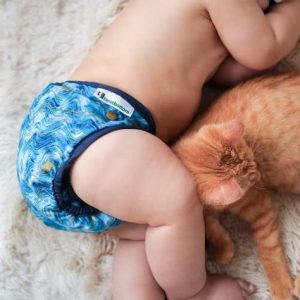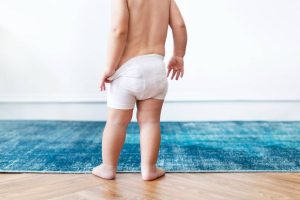How to wash reusable diapers? Reusable diapers are an eco-friendly and economical choice for many families. However, the laundry routine can seem daunting at first. Fear not! This comprehensive guide will break down the process of washing reusable diapers into simple steps.
Getting Started: Supplies and Organization
Before diving into the wash, gather the necessary supplies:
Diaper pail:
A well-ventilated pail with a lid is ideal for storing soiled diapers.
Detergent:
Choose a cloth-safe detergent that is free of dyes and perfumes.
Sprayer (optional):
A sprayer can help with pre-rinsing waste.
Wet bag (optional):
A wet bag is a portable, waterproof bag for storing soiled diapers while on the go.
Organization is key! Dedicate a laundry basket or bin specifically for soiled diapers. Line the diaper pail with a washable liner for easier cleanup.
Prepping for the Wash: Preamble to Cleanliness
- Solids Removal: Scrape or dunk soiled diapers in a toilet to remove solid waste. Flushing waste is generally not recommended, as it can clog toilets.
- Pre-Rinse (optional): If you choose to pre-rinse, use a dedicated sprayer to remove any remaining residue.
- Store in Pail: Place rinsed or scraped diapers in the pail. Do not overload the pail, as this can trap moisture and odors.
Wash Day Routine: The Main Event
- Frequency: Wash diapers every 2-3 days, or sooner if needed.
- Sorting: Some washing machines require separating heavily soiled diapers from lightly soiled ones. Check your machine’s manual for guidance.
- Water Temperature: Use warm or hot water, following the diaper manufacturer’s recommendations. Hot water can be more effective for cleaning, but avoid excessively high temperatures that can damage the diapers.
- Detergent: Use a cloth-safe detergent and follow the recommended dosage on the package. Avoid using fabric softeners, which can build up on the diapers and reduce their absorbency.
- Wash Cycle: Choose a heavy-duty or bulky cycle for a thorough clean.
Most washing machines offer an extra rinse cycle. This step is highly recommended for reusable diapers, as it helps remove any leftover detergent residue that can irritate your baby’s skin.
Drying: Sunshine or Machine?
Air drying is the preferred method for reusable diapers, as it preserves the fabric and elasticity. Hang diapers on a drying rack or line in direct sunlight, if possible.
Tumble drying can be used on low heat as a last resort. However, avoid high heat settings, which can damage the diapers’ waterproof layer.
Diaper Care Beyond the Wash: Maintaining Freshness
- Stripping: Occasionally, diapers may require stripping to remove built-up detergent residue or minerals from hard water. Check the diaper manufacturer’s website for specific stripping instructions.
- Stains: For stubborn stains, pre-treat with a cloth-safe stain remover before washing.
- Storage: Store clean diapers in a cool, dry place.
Troubleshooting Common Issues: Addressing Challenges
Leaks: Leaks can occur for various reasons. Ensure a proper fit, check for worn-out elastics, and inspect for any tears in the fabric.
Detergent Build-Up: If your diapers are experiencing ammonia buildup or repelling moisture, they might require stripping.
Odors: Persistent odors can indicate a residue buildup. Increase the rinse cycle or try stripping the diapers.
Washing reusable diapers might seem like an extra chore initially. However, with a consistent routine, the process becomes second nature. Remember, reusable diapers offer significant environmental and financial benefits. Most importantly, they keep your baby comfortable and dry.
Building a Routine: Consistency is Key
Washing reusable diapers becomes easier with a consistent routine. Here are some tips to streamline the process:
- Designated Laundry Day: Choose specific days for washing diapers. This helps prevent them from sitting in the pail for too long and developing odors.
- Double Duty Laundry: Combine washing diapers with other laundry loads, optimizing your washing machine’s capacity and saving time.
Eco-Friendly Considerations: Washing Green
- Cloth-Safe Detergent: Opt for concentrated detergents that are effective in smaller doses. This reduces packaging waste.
- Natural Cleaning Boosters: Consider adding a natural cleaning booster, like baking soda or washing soda, to your wash cycle for extra cleaning power.
- Air Drying: Whenever possible, air dry your diapers instead of using a machine dryer. This saves energy and extends the lifespan of the diapers.
The Power of Teamwork: Sharing the Load
- Divide and Conquer: If you have a partner, share diaper washing responsibilities. This can help make the task feel less overwhelming.
- Involve Older Siblings: Older siblings can help with age-appropriate tasks like hanging diapers to dry or sorting lightly soiled diapers.
Remember, washing reusable diapers is a learning process. Find what works best for you and your family. With a little planning and these helpful tips, you can establish a smooth and eco-friendly diaper washing routine.
Advanced Washing Techniques: For Extra Cleaning Power
While the basic wash routine is effective, there are additional techniques you can incorporate for stubborn stains or situations where extra cleaning might be needed.
-
Pre-Soaking: For particularly soiled diapers or diapers that have sat for longer periods, pre-soaking in a mixture of warm water and a cloth-safe stain remover can be helpful. Follow the manufacturer’s instructions for pre-soak time and solution strength.
-
Bleach (Use with Caution): Only use chlorine-free bleach specifically designed for cloth diapers. Regular bleach can damage the fabric and waterproofing. Check the diaper manufacturer’s instructions for proper dilution and usage.
-
Water Softener: If you have hard water, consider adding a water softener to your wash cycle. This can help prevent mineral buildup on the diapers which can impact absorbency.
Remember, these advanced techniques should be used sparingly and only when necessary. Always prioritize following the diaper manufacturer’s specific care instructions.

Caring for Your Cloth Diapers: Beyond the Wash
Washing is a crucial part of the reusable diaper routine, but proper care extends beyond the laundry cycle. Here are some tips for keeping your cloth diapers in tip-top shape:
-
Inspections: Regularly inspect your diapers for rips, tears, or loose seams. Damaged diapers may leak and need to be repaired or replaced.
-
Elasticity Check: Over time, the elastic around the legs and waist of the diaper can lose its stretch. Test the elasticity by gently pulling on the leg and waist openings. If they don’t spring back easily, consider replacing the elastics or the entire diaper.
-
Sunning: Sunshine is a natural disinfectant and can help freshen diapers and eliminate lingering odors. Occasionally lay out clean, dry diapers in direct sunlight for a refresh.
-
Storage: Store clean diapers in a cool, dry place. Avoid storing them in airtight containers, as this can trap moisture and create a breeding ground for bacteria.
By incorporating these simple care practices into your routine, you can extend the lifespan of your cloth diapers and ensure they continue to provide optimal performance for your baby.









